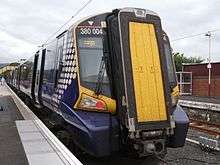British Rail Class 380
| British Rail Class 380 Desiro | |
|---|---|
|
Class 380 "Desiro" EMU 380007 at Railfest 2012 | |
|
The interior of an Abellio ScotRail Class 380 | |
| In service | 8 December 2010 - Current |
| Manufacturer | Siemens |
| Built at | Krefeld, Germany |
| Family name | Desiro |
| Constructed | 2009 - 2011 |
| Number built | 38 trainsets |
| Formation | 3 or 4 cars per trainset |
| Fleet numbers |
|
| Capacity |
|
| Operator(s) | Abellio ScotRail |
| Depot(s) | Glasgow Shields Road TMD |
| Line(s) served |
|
| Specifications | |
| Car length | 23 m (75 ft 6 in)[1] |
| Maximum speed | 100 mph (161 km/h) |
| Electric system(s) | 25 kV 50 Hz AC Overhead |
| Current collection method | Pantograph |
| Track gauge | 1,435 mm (4 ft 8 1⁄2 in) standard gauge |

The Class 380 Desiro is a type of electric multiple-unit train that operates on the national railway network in Scotland.
The Siemens "Desiro UK" family also includes units of 185, 350, 360, 444 and 450.
Description
The trains operate Abellio ScotRail services in the Ayrshire and Inverclyde region of Scotland and had originally been intended for the cancelled Glasgow Airport Rail Link. The construction was awarded to Siemens and announced by Transport Scotland on 11 July 2008.[2]
A total of 38 sets were ordered, comprising 22 three-car and 16 four-car units. Stations along the Ayrshire Coast Line and Inverclyde Line underwent platform extension works to allow the use of the longer trains.[3] The trains were specified to have full access for disabled people and to have streamlined end corridor connections. On the unveiling of the first completed vehicle, it was announced that the fleet would be divided into two sub-groups, with the 3-car units Class 380/0 and the 4-car as Class 380/1.[4]
In September 2010, commissioning of the fleet was suspended by ScotRail due to technical issues with the trains.[5] The reliability issues and extended commissioning period resulted in an initially reduced service on parts of the ScotRail network, including the newly re-opened Airdrie-Bathgate line.[6]
The fleet is based at Glasgow Shields Road TMD. Introduction of the fleet resulted in the cascading of the Class 334 "Juniper" and Class 318 fleet which previously operated the Ayrshire Coast Line and Inverclyde Line.[1] The North Berwick Line operations was a Class 322 fleet replacement. The Class 334 "Juniper" stock were cascaded onto the North Clyde Line to Edinburgh Waverley, the Class 318s were cascaded onto the Argyle Line, and Class 322 cascaded onto the Wakefield Line with Northern Rail.
Operations
The fleet was introduced into public service on 8 December 2010 with 380111 operated the 16:26 from Paisley Gilmour Street to Ayr, followed on 9 December 2010 by 380102 and 380001 which worked the 15:30 Glasgow Central to Ayr service.
The North Berwick Line has been using these trains since 2011.
From 21 November 2012, the Class 380 are also seen operating the Paisley Canal Line. Electrification of the section of line from Corkerhill to Paisley Canal, to a plan devised by a ScotRail and Network Rail alliance, began in July 2012[7] and was completed in November 2012. The electrification works were undertaken during night time and weekend possessions, resulting in the route closing after 8pm on Monday to Thursday evenings, all day on Saturdays, and for an eight-day period in October, with work starting on 29 September 2012 and intending to be completed by 8 November 2012.[8][9] Class 314 and Class 380 "Desiro" electric multiple units supplemented the existing Class 156 "Super Sprinter" diesel multiple units from energisation of the wires in November 2012. From the timetable change in December 2012, the Class 156 "Super Sprinter" were moved to other routes.
Following the December 2014 timetable change, with the electrification of the Whifflet Line, services to Lanark were re-routed into Glasgow Central High Level. Alongside the usual Class 318's and Class 320's, the Class 380s have often been used on the route.
From December 2016 Class 380s will operate some services on the newly electrified line between Glasgow Queen Street and Edinburgh Waverley via Falkirk. This will continue until the Class 385's are introduced in autumn 2017.[10]
Fleet details
| Class | Operator | No. Built | Year Built | Cars per Set | Unit nos. |
|---|---|---|---|---|---|
| Class 380/0 | Abellio ScotRail | 22 | 2009–2011 | 3 | 380001 – 380022 |
| Class 380/1 | 16 | 4 | 380101 – 380116 | ||
References
- 1 2 "Desiros unveiled ready for ScotRail services". Rail (648). 14 July 2010.
- ↑ "New Electric Trains for Scotland's Growing Railways". Transport Scotland. 11 July 2008.
- ↑ "New trains bring 9,000 more seats". BBC News. 11 July 2008. Retrieved 29 July 2008.
- ↑ "Siemens introduce the new Class 380 'Desiro'" (PDF). Railway Herald (202). 23 November 2009. p. 3. Retrieved 13 July 2010.
- ↑ "Rail network hits buffers as trains fail". The Scotsman. Edinburgh. 9 October 2010.
- ↑ Damien Henderson (9 October 2010). "Train shortage fears as £200m fleet is refused". The Herald. Glasgow.
- ↑ "£12m "alliance" investment for Paisley Canal line" (Press release). First Group. 11 July 2012. Retrieved 28 June 2013.
- ↑ "Alliance cuts cost of Paisley Canal line electrification". Railway Gazette International. London. 11 June 2012. Retrieved 28 June 2013.
- ↑ "Paisley Canal timetable changes". First ScotRail. Archived from the original on 13 November 2012. Retrieved 28 June 2013.
- ↑ "ScotRail's AT200 EMU interior unveiled at Edinburgh Waverley". Global Rail News. 10 February 2016. Retrieved 16 March 2016.
External links
| Wikimedia Commons has media related to British Rail Class 380. |

